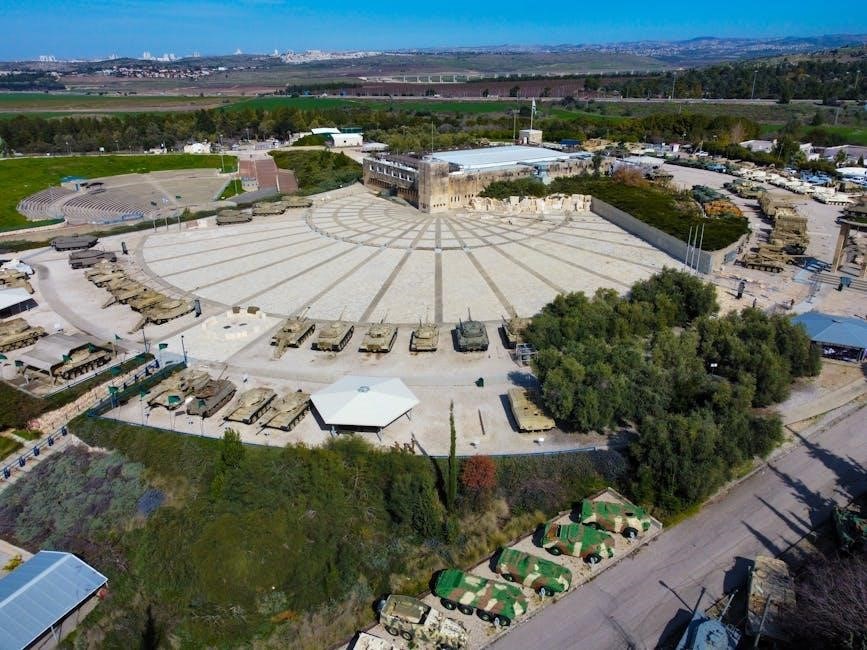Israel’s history spans millennia, from the covenant with Abraham to the modern state. This timeline explores key events, kingdoms, and transformations shaping its enduring legacy and identity.
1.1. Overview of Israel’s Historical Significance
Israel’s history is deeply intertwined with its religious, cultural, and political identity. Situated at the crossroads of civilizations, the land has witnessed pivotal moments shaping global history. From the biblical patriarchs to the modern state, Israel’s narrative is marked by resilience and transformation. Its significance lies in being the ancestral homeland of the Jewish people, a cradle of monotheistic faiths, and a symbol of enduring identity amidst shifting empires and migrations. The timeline of Israel’s history reflects both its ancient roots and its modern rebirth, offering insights into the complexities of its past and its ongoing influence on the world stage.

1.2. Purpose of the Timeline
The timeline serves as a chronological guide to Israel’s history, offering a structured overview of major events from ancient times to the modern era. Its purpose is to provide clarity and context, enabling readers to understand the progression of Israel’s development. By organizing key historical milestones, the timeline helps trace the evolution of Israel’s identity, conflicts, and transformations. It bridges the gap between past and present, making the rich and complex history accessible. This tool is invaluable for students, researchers, and enthusiasts seeking a comprehensive understanding of Israel’s journey through the ages, highlighting its enduring legacy and relevance in global history.
Ancient History of Israel
Ancient Israel’s history begins with the Patriarchs, followed by the Exodus, conquest of Canaan, and the Judges, shaping its identity and faith through divine covenants and leadership transitions.

2.1. The Patriarchs: Abraham, Isaac, and Jacob
Abraham, Isaac, and Jacob are the foundational figures of Israel’s history. Abraham, considered the father of the nation, received God’s covenant promising land and descendants. Isaac, his son, remained faithful, while Jacob, later named Israel, fathered the twelve tribes; Their journeys and divine interactions established Israel’s spiritual and territorial identity, setting the stage for future generations.

2.2. Moses and the Exodus from Egypt
Moses emerged as a pivotal leader, guiding the Israelites out of Egyptian bondage. The Exodus, marked by miraculous events like the parting of the Red Sea, symbolized divine liberation. Moses received the Ten Commandments on Mount Sinai, establishing a covenant and moral framework for the nation. This period laid the groundwork for Israel’s identity, transitioning from slavery to a unified people under God’s leadership. The Exodus remains a cornerstone of Israel’s historical narrative, signifying freedom and the beginning of their journey as a distinct nation.

2.3. The Conquest of Canaan under Joshua
Following Moses’ death, Joshua led the Israelites into Canaan, marking the beginning of its conquest. The fall of Jericho and the victory at Ai demonstrated divine favor and strategic leadership. Joshua’s military campaigns unified the tribes and secured key territories, solidifying Israel’s presence in the Promised Land. The conquest laid the foundation for future kingdoms and established a covenantal relationship with the land, shaping Israel’s identity and destiny.
2.4. The Period of the Judges
The period of the judges followed Joshua’s conquest, lasting from approximately 1200 to 1020 BCE. During this time, Israel was governed by charismatic leaders raised by God to deliver the people from oppression. Judges like Othniel, Ehud, Deborah, Gideon, and Samson played pivotal roles in defending Israel against neighboring nations. This era was marked by a recurring cycle: sin, oppression, repentance, and deliverance. The judges maintained tribal unity and upheld covenant obligations, though their authority was decentralized. The period concluded with increasing instability, leading to the demand for a monarchy. This transitional phase shaped Israel’s identity and laid the groundwork for the rise of the kingdoms under Saul, David, and Solomon.

The Rise of the Kingdoms of Israel
The transition from tribal governance to monarchy began with Saul, followed by David and Solomon, uniting Israel before dividing into two kingdoms, Israel and Judah.
3.1. The United Monarchy: King Saul, King David, and King Solomon
The United Monarchy of Israel began with King Saul, who united the tribes under one rule. King David succeeded Saul, establishing Jerusalem as the capital and strengthening Israel’s political and military power. David’s reign, marked by conquests and religious reforms, laid the foundation for his son, King Solomon. Solomon, renowned for his wisdom, oversaw a golden age of prosperity and culture, constructing the First Temple in Jerusalem. His reign, however, ended with tensions that would later divide the kingdom. The United Monarchy period (c. 1020–930 BCE) was pivotal in shaping Israel’s identity, governance, and religious institutions.
3.2. The Divided Kingdoms: Israel and Judah
Following King Solomon’s death in 930 BCE, Israel split into two kingdoms: the Northern Kingdom of Israel and the Southern Kingdom of Judah. The Northern Kingdom, with its capital in Samaria, was ruled by various dynasties and faced frequent political instability. Judah, with Jerusalem as its capital, maintained a more stable monarchy under the Davidic line. Both kingdoms experienced periods of prosperity and decline, with Israel falling to the Assyrians in 722 BCE and Judah eventually succumbing to the Babylonians in 586 BCE. This division marked a critical era in Israel’s history, shaping distinct religious and cultural identities for each kingdom. Prophets like Elijah and Elisha in Israel, and Isaiah and Jeremiah in Judah, played pivotal roles during this time.
3.3. The Fall of the Northern Kingdom (Israel)
The Northern Kingdom of Israel fell to the Assyrian Empire in 722 BCE, marking a pivotal moment in its history. The Assyrians, under King Shalmaneser V and later Sargon II, besieged and captured the capital, Samaria. The inhabitants were deported to various parts of the Assyrian Empire, leading to the dispersal of the ten tribes of Israel. This event, known as the Assyrian Conquest, resulted in the loss of Israel’s political independence. The region was subsequently repopulated with Assyrian settlers, blending cultures and religions. The fall of Israel was attributed to internal divisions, moral decay, and disregard for prophetic warnings. This period signified the end of the Northern Kingdom’s existence as a sovereign state, leaving only the Southern Kingdom of Judah to carry on the Israelite legacy.
3.4. The Fall of the Southern Kingdom (Judah)
The Southern Kingdom of Judah fell to the Babylonian Empire in 586 BCE, marking the end of its independence. The Babylonians, under King Nebuchadnezzar II, besieged Jerusalem, destroying the First Temple and deporting much of Judah’s population to Babylon. This event, known as the Babylonian Exile, lasted for 70 years and profoundly impacted Jewish identity and religion. The fall of Judah was attributed to its rebellion against Babylonian rule and its failure to heed prophetic warnings. Despite the exile, the Jewish people maintained their cultural and religious traditions, laying the foundation for their eventual return and the rebuilding of Jerusalem. This period remains a pivotal moment in Israel’s history, shaping its spiritual and national identity.
The Exilic and Intertestamental Periods
This era spans the Babylonian Exile, the return under Persian rule, and the intertestamental period, marked by cultural and religious evolution, setting the stage for later Jewish history.
4.1. The Babylonian Exile and Its Impact
The Babylonian Exile, occurring in 586 BCE, was a pivotal event in Israel’s history. Following the fall of Jerusalem and the destruction of the First Temple, the Jewish population was forcibly deported to Babylon. This period of captivity lasted approximately 70 years, profoundly impacting Jewish identity and religious practices. The Exile led to significant theological reflections, including the development of synagogue worship and a heightened focus on scripture. Despite their dispersion, the Jewish community maintained cohesion through shared traditions and messianic hopes. The Exile’s legacy is evident in the eventual restoration and the enduring resilience of the Jewish people, shaping their collective memory and faith.
4.2. The Second Temple Period and the Maccabean Revolt
The Second Temple Period began with the rebuilding of the Temple in Jerusalem around 516 BCE, following the Babylonian Exile. This era saw the restoration of Jewish worship and the rise of influential groups like the Pharisees and Sadducees. However, the period was marked by challenges, including Hellenistic influence under Greek rule. The Maccabean Revolt (167–160 BCE) emerged as a response to Antiochus IV’s desecration of the Temple and imposition of Greek practices. Led by the Maccabee family, the revolt succeeded in reclaiming Jerusalem and rededicating the Temple, an event commemorated during Hanukkah. This period emphasized Jewish identity, resistance to assimilation, and the enduring hope for autonomy, leaving a lasting impact on Jewish tradition and resilience.

The Modern Era

Israel’s modern era began with its 1948 establishment, marked by the Arab-Israeli War and ongoing conflicts. The period from 1949 onward highlights Israel’s development, challenges, and resilience.
5.1. The Zionist Movement and the Establishment of the State of Israel
The Zionist movement emerged in the late 19th century, advocating for a Jewish homeland in Palestine. Led by figures like Theodor Herzl, it gained momentum post-WWII. The 1947 UN Partition Plan divided Palestine into Jewish and Arab states. On May 14, 1948, David Ben-Gurion declared Israel’s independence, establishing the modern state. This marked the realization of Zionist ideals, although it sparked regional conflict. The new state absorbed Jewish immigrants worldwide, laying the foundation for a sovereign nation.

5.2. The 1948 Arab-Israeli War and Its Aftermath
The 1948 Arab-Israeli War began immediately after Israel’s declaration of independence on May 14, 1948. Five Arab nations—Egypt, Syria, Transjordan, Lebanon, and Iraq—invaded the new state, aiming to prevent its establishment. The war lasted until 1949, ending with the Armistice Agreements that established temporary borders. Israel gained control of 78% of Palestine, while Jordan occupied the West Bank and Egypt controlled Gaza. The war resulted in significant territorial changes and the displacement of over 750,000 Palestinians, known as the Nakba or “catastrophe” in Arabic. It also solidified Israel’s sovereignty but left unresolved conflicts that continue to shape the region’s geopolitics.

5.3. Contemporary Israel: From 1949 to the Present
Following the 1948 Arab-Israeli War, Israel entered a period of rapid development, absorbing hundreds of thousands of Jewish immigrants. The 1967 Six-Day War expanded its territories, including the West Bank and Gaza, sparking ongoing tensions. The 1973 Yom Kippur War and subsequent peace treaties with Egypt and Jordan reshaped regional dynamics. The Oslo Accords in 1993 aimed to establish Palestinian autonomy but faced setbacks amid violence. Today, Israel is a global leader in technology and innovation, yet challenges persist, including conflicts with Hamas, disputes over settlements, and internal political divisions. Its identity as a Jewish and democratic state remains central to its national discourse and international relations.
Israel’s history is a testament to resilience and transformation, blending ancient traditions with modern nationhood, leaving an enduring legacy that continues to shape global and regional dynamics.
6.1. The Enduring Legacy of Israel’s History
Israel’s history has profoundly shaped global culture, religion, and politics. From the patriarchs to modern statehood, its legacy influences identity, faith, and conflict resolution, offering timeless lessons for humanity.
6.2. The Importance of Understanding the Timeline
Understanding the timeline of Israel’s history is crucial for grasping its complexities and significance. It provides a chronological framework to trace the evolution of its identity, conflicts, and cultural contributions. By examining key events, one can better comprehend the interplay of religion, politics, and geography that have shaped the region. This knowledge also offers insights into the roots of modern conflicts and the resilience of its people. Studying the timeline fosters a deeper appreciation for Israel’s diverse heritage and its enduring impact on global history. It serves as a vital tool for contextualizing past and present, making it essential for anyone seeking to understand this fascinating and complex nation.
